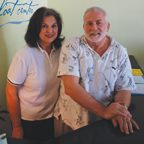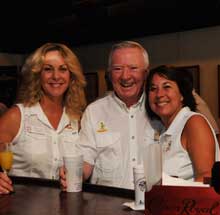Lowcountry Weekly's MARK SHAFFER floats toward epiphany… or something like it.
It is an odd sensation being weightless. As bipedal land mammals we have no real reference for it. Nevertheless, I am weightless – suspended in a warm, soothing salt solution more buoyant than the Dead Sea.
 There is little difference in temperature between air and water, where one begins and the other ends becomes virtually indistinguishable. There is no light. The only sound is the occasional drip of condensation and the beat of my own heart. This is where the left brain takes a nap and all the white noise it bangs out goes mute. This is where the right brain goes to a day spa.
There is little difference in temperature between air and water, where one begins and the other ends becomes virtually indistinguishable. There is no light. The only sound is the occasional drip of condensation and the beat of my own heart. This is where the left brain takes a nap and all the white noise it bangs out goes mute. This is where the right brain goes to a day spa.
I am ready for my epiphany.
Ron and Linda Burd shared an epiphany: he had to get off the trading floor of the Chicago Stock Exchange and start living life. He also had to do something about the chronic back pain brought on by thirty years in the pits, up to his eyeballs in pure adrenalin-soaked stress. He needed to relax. “The definition of stress,” Linda points out, “is relentless interruption.” The Burds decided to forsake the high pressure of the Windy City for quality time and a more laid-back lifestyle. They set down roots in their favorite vacation spot, moving to Hilton Head in 1998. As they acclimated to island time the stress levels decreased exponentially, but the floatation therapy Ron needed to ease his back pain was a five hour drive away in Atlanta. Necessity being the mother of invention, Ron’s need for relief merged with Linda’s experience in the franchise industry, and eventually the Inner Vision Float Center was born.
Until now, my own experience with what’s been simplified to “floating” begins and ends with Ken Russell’s 1980 film of the Paddy Chayefsky novel Altered States. Scientist William Hurt researches different states and levels of consciousness by climbing into this big clunky metal tank and regressing into his primal self – or something. Back then this was called “sensory deprivation.” Whatever the outcome, it didn’t look relaxing. Ron assures me the Inner Vision experience poses no threat of whatever it was that happened to Bill Hurt.
The original idea dates back to 1954 when Dr. John Lilly (the basis for Hurt’s character) conducted ground-breaking research on the effects of isolation on the mind at the National Institute of Health. He invented the famous sensory deprivation tank as part of this research and found that by inducing weightlessness and removing most of the five senses something very interesting happened. “What they found, in fact,” explains Ron, “was by suspending left brain thinking they enhanced right brain thinking: the creative, the holistic, the intuitive – the Big Picture thinking. And that presented a whole different set of parameters. What floatation is called now is R.E.S.T. or restrictive environmental stimulation technique.”
Linda further simplifies the concept. “There’s no hocus pocus. It’s water and salt.”
Lots and lots of salt: half a ton of Epsom salts to 225 gallons of water circulated through a state of the art filtration system. Germaphobes need not worry, the concentration of salt also renders the environment completely sterile.
Following a brief orientation, I’m issued a basket filled with ultra plush towels, robe, slippers and ear plugs of surgical wax (you don’t want this kind of water in your ears). I shower in luxury in the spa-like changing room, don the robe and slippers and pad across the hall to my float tank.
 This is not Bill Hurt’s tank – far from it. This is more like what might happen if a Swedish sauna and a California hot tub spent a romantic weekend together at Lake Cuomo. There is nothing austere or claustrophobic about it. The old tanks were not meant for even the mildly claustrophobic, with just four feet of head room. The new tanks double that, measuring eight feet high, eight feet long and four feet wide. Once inside I have some seemingly minor options that impact the experience in major ways. I can listen to the piped-in music, plug in my own tunes, or float in silence. Should I leave the light on or float in total darkness? I opt for the silent dark.
This is not Bill Hurt’s tank – far from it. This is more like what might happen if a Swedish sauna and a California hot tub spent a romantic weekend together at Lake Cuomo. There is nothing austere or claustrophobic about it. The old tanks were not meant for even the mildly claustrophobic, with just four feet of head room. The new tanks double that, measuring eight feet high, eight feet long and four feet wide. Once inside I have some seemingly minor options that impact the experience in major ways. I can listen to the piped-in music, plug in my own tunes, or float in silence. Should I leave the light on or float in total darkness? I opt for the silent dark.
I step into the tank, sink into the warm, strangely silky water with Ron’s words floating in my head. “The water is heated to 94 degrees, which is skin temperature. Consequently, the air is also about 94 degrees. So when you are completely buoyant and the water and air are the same temperature as your body, you get – for lack of a better term – an out of body feeling because there’s nothing to relate to.” Ironically, somehow I can relate to that.
Float sessions run an hour, but inside the tank time has little meaning. Once again, there simply is no point of reference. Float time may seem longer or shorter depending upon the individual’s of state of mind and relaxation. And like just about everything else (seventh grade guitar lessons the exception) the more you float, the better it gets. Linda tells me that typically one begins to get into a sort of groove by the end of the third session. Perhaps this has something to do with muscle memory. Or perhaps it’s better described as a brief muscular amnesia. The first float is all about allowing oneself to relax enough to let go and just be, to accept zero gravity. This is not normal. We don’t do this well. We fight it. Oh, you may think, gentle reader, that a semi-comatose Sunday afternoon on the couch zoned out on the Golf Channel is just as relaxing. No. You might as well be trapped in rush hour traffic with a migraine and a screaming child compared to this.
 The benefits of floating away one’s stress and worries date back centuries. Civilizations have always congregated around hot springs and mineral pools. As you suspected, floating has long been used in Europe as a popular and accepted method of aiding behavior modification in the treatment of addiction and obesity. Pregnant women seek the zero-G’s for total mother and child stress reduction. Some research indicates athletes recover more quickly and achieve greater performance levels with regular R.E.S.T. The enhanced right brain function fuels the creative side. Students often play lessons and language programs while they float. Writers and artists float to troll the psyche for fresh inspiration, to break down the walls. Linda recalls the experience of a video game designer under pressure for a final project in a highly competitive situation: “He came and he floated and he got out and said, ‘I got it!’ ” The tank, it seems is a good place for an epiphany.
The benefits of floating away one’s stress and worries date back centuries. Civilizations have always congregated around hot springs and mineral pools. As you suspected, floating has long been used in Europe as a popular and accepted method of aiding behavior modification in the treatment of addiction and obesity. Pregnant women seek the zero-G’s for total mother and child stress reduction. Some research indicates athletes recover more quickly and achieve greater performance levels with regular R.E.S.T. The enhanced right brain function fuels the creative side. Students often play lessons and language programs while they float. Writers and artists float to troll the psyche for fresh inspiration, to break down the walls. Linda recalls the experience of a video game designer under pressure for a final project in a highly competitive situation: “He came and he floated and he got out and said, ‘I got it!’ ” The tank, it seems is a good place for an epiphany.
Epiphany eludes me this time. However, Ron was right, time loses all meaning utterly suspended in the black listening to the beat of one’s own heart, gradually becoming aware that it has slowed dramatically. By the time the filtration system starts to pump signaling the end of the session, my time in the tank might have been five minutes or five hours. I’m absolutely tranquil, a little bit disoriented at first (getting used to gravity again) and for the first time in recent memory the chronic kink in my neck is on sabbatical. I feel great.
Dr. Lilly once wrote, “In the mind, there are no limits.” As Earth-bound beings we’re taught to believe that gravity is the one law you can’t break. As it turns out, not only can you break it for a spell at Inner Vision Float Center, you can feel good about doing so.
Inner Vision Float Center is located in the Hilton Head Health and Wellness Building, No. 2 Marshland Road, suite 7. Sessions are available by appointment seven days a week. For more information call 843-682-4400 or visit their website: www.innervisionfloatcenter.com
Mark Shaffer is a freelance writer and special correspondent to Lowcountry Weekly. Always on the look out for interesting story ideas, he can be reached at marks@lcweekly.








